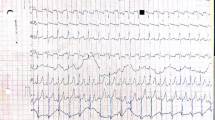Abstract
Infants with phosphomannomutase 2 – congenital disorder of glycosylation (PMM2-CDG), formerly known as CDG1a, present with failure to thrive, visceral dysfunction, thromboembolic events and developmental delays noted before 6 months of age. Diagnosis is often delayed due to the considerable variability in phenotype. Characteristic, but not universal, features include inverted nipples and abnormal subcutaneous fat pads. Neuroimaging performed in the first 4 months of life may be normal, although cerebellar and brainstem atrophy is usual after 3 months of age. Cerebellar and brainstem atrophy have been noted as early as 11 days of life. We present an infant whose typical subcutaneous and retroperitoneal fat deposits were clinically occult, but identified on body MRI.


Similar content being viewed by others
References
Funke S, Gardeitchik T, Kouwenberg D et al (2013) Perinatal and early infantile symptoms in congenital disorders of glycosylation. Am J Med Genet A 161:578–584
Online Mendelian Inheritance in Man, OMIM®. Johns Hopkins University, Baltimore, MD. MIM Number: (212065): Edited 06/12/2013. World Wide Web URL: http://omim.org/
Sparks SE, Krasnewich DM (eds) (2005) Congenital disorders of glycosylation overview. In: Pagon RA, Bird TD, Dolan CR et al (eds) SourceGeneReviews™ . Seattle (WA): University of Washington, Seattle; 2005 Aug 15 (updated 2012 Nov 08)
Al-Maawali A, Blaser S, Yoon G (2012) Diagnostic approach to childhood-onset cerebellar atrophy: a 10-year retrospective study of 300 patients. J Child Neurol 27:1121–1132
Feraco P, Mirabelli-Badenier M, Severino M et al (2012) The shrunken, bright cerebellum: a characteristic MRI finding in congenital disorders of glycosylation type 1a. AJNR Am J Neuroradiol 33:2062–2067
Pascual-Castroviejo I, Pascual-Pascual SI, Quijano-Roy S et al (2006) Cerebellar ataxia of Norman-Jaeken. Presentation of seven Spanish patients. Rev Neurol 42:723–728
Wright EM, Suri M, White SM et al (2011) Pierpont syndrome: a collaborative study. Am J Med Genet A 155A:2203–2211
Sapp JC, Turner JT, van de Kamp JM et al (2007) Newly delineated syndrome of congenital lipomatous overgrowth, vascular malformations, and epidermal nevi (CLOVE syndrome) in seven patients. Am J Med Genet A 143A:2944–2958
Acknowledgment
We thank Mary-Louise Greer, MBBS, for manuscript review and suggestions.
Conflicts of interest
None
Author information
Authors and Affiliations
Corresponding author
Rights and permissions
About this article
Cite this article
Al-Maawali, A.A., Miller, E., Schulze, A. et al. Subcutaneous fat pads on body MRI – an early sign of congenital disorder of glycosylation PMM2-CDG (CDG1a). Pediatr Radiol 44, 222–225 (2014). https://doi.org/10.1007/s00247-013-2782-2
Received:
Revised:
Accepted:
Published:
Issue Date:
DOI: https://doi.org/10.1007/s00247-013-2782-2




